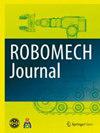对抗性多关节人工肌肉驱动多串联机构的稳定性分析
IF 1.7
Q3 INSTRUMENTS & INSTRUMENTATION
引用次数: 0
摘要
人工多关节肌肉骨骼系统由单关节和多关节肌肉驱动的串联链接组成,通常受到脊椎动物的启发,使机器人能够进行动态,优雅和灵活的运动。然而,由多关节肌肉驱动的串联连接会导致不稳定的运动(例如屈曲)。拮抗性多关节肌驱动的肌肉骨骼机制的稳定性取决于肌肉的形态、肌肉的起源/插入、肌肉的弹簧常数、肌肉的收缩力和其他因素。我们分析了由拮抗多关节肌肉驱动的多串联连杆机制的稳定性,旨在避免屈曲和其他不希望的运动。从理论上推导了系统的势能和目标点的稳定状态,并通过动态仿真和实验验证了结果。本文提出了由单关节和多关节肌肉冗余驱动的串联机器人的静态稳定性准则,从而给出了该类机器人的设计和控制准则。本文章由计算机程序翻译,如有差异,请以英文原文为准。
Stability analysis of multi-serial-link mechanism driven by antagonistic multiarticular artificial muscles
Artificial multiarticular musculoskeletal systems consisting of serially connected links driven by monoarticular and multiarticular muscles, which are often inspired by vertebrates, enable robots to elicit dynamic, elegant, and flexible movements. However, serial links driven by multiarticular muscles can cause unstable motion (e.g., buckling). The stability of musculoskeletal mechanisms driven by antagonistic multiarticular muscles depends on the muscle configuration, origin/insertion of muscles, spring constants of muscles, contracting force of muscles, and other factors. We analyze the stability of a multi-serial-link mechanism driven by antagonistic multiarticular muscles aiming to avoid buckling and other undesired motions. We theoretically derive the potential energy of the system and the stable condition at the target point, and validate the results through dynamic simulations and experiments. This paper presents the static stability criteria of serially linked robots, which are redundantly driven by monoarticular and multiarticular muscles, resulting in the design and control guidelines for those robots.
求助全文
通过发布文献求助,成功后即可免费获取论文全文。
去求助
来源期刊

ROBOMECH Journal
Mathematics-Control and Optimization
CiteScore
3.20
自引率
7.10%
发文量
21
审稿时长
13 weeks
期刊介绍:
ROBOMECH Journal focuses on advanced technologies and practical applications in the field of Robotics and Mechatronics. This field is driven by the steadily growing research, development and consumer demand for robots and systems. Advanced robots have been working in medical and hazardous environments, such as space and the deep sea as well as in the manufacturing environment. The scope of the journal includes but is not limited to: 1. Modeling and design 2. System integration 3. Actuators and sensors 4. Intelligent control 5. Artificial intelligence 6. Machine learning 7. Robotics 8. Manufacturing 9. Motion control 10. Vibration and noise control 11. Micro/nano devices and optoelectronics systems 12. Automotive systems 13. Applications for extreme and/or hazardous environments 14. Other applications
 求助内容:
求助内容: 应助结果提醒方式:
应助结果提醒方式:


